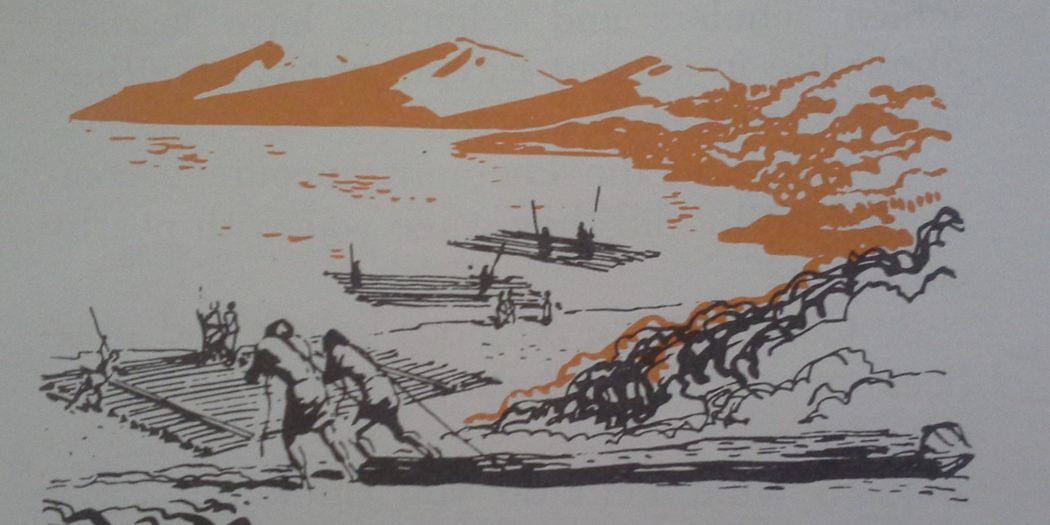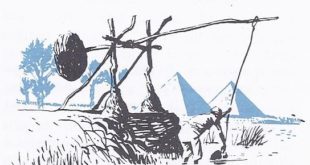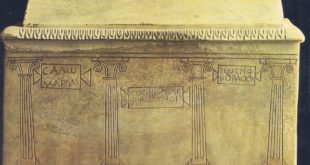Now Hiram, King of Tyre, sent his servants to Solomon, when he heard that they had anointed him King. . . And Solomon sent word to Hiram, “ . . . I purpose to build a house for the name of the Lord my God. . . Now therefore command that cedars of Lebanon be cut for me; and . . . I will pay you for your servants such wages as you set; for you know that there is no one among us who knows how to cut timber like the Sidonians [people of the city of Sidon].”
. . . And Hiram sent to Solomon, saying, “. . . I am ready to do all you desire in the matter of cedar and cypress timber. My servants shall bring it down to the sea from Lebanon; and I will make it into rafts to go by sea to the place you direct and I will have them broken up there, and you shall receive it; and you shall meet my wishes by providing food for my household.” So Hiram supplied Solomon with all the timber of cedar and cypress that he desired. while Solomon gave Hiram twenty thousand cors [measures] of wheat as food for his household and twenty thousand cors of beaten oil. . . And there was peace between Hiram and Solomon; and the two of them made a treaty. And King Solomon built a fleet of ships. . . And Hiram sent with the fleet his servants, seamen who were familiar with the sea. . .
These words adapted from the Bible tell the story of trade agreements between two kings who ruled about 1000 B.C. You have probably heard of Solomon. He had the reputation of being the wisest king of ancient times. But who was King Hiram of Tyre and Sidon? Why should Hiram’s people be noted for their skill as carpenters and seamen? And why was Solomon intent on erecting a temple to God?

We saw how the civilized people of the Nile and Tigris-Euphrates valleys traded with their upland neighbours and sailed along the shores of the sea in search of things lacking in their own country. Here we read about how neighbouring peoples first copied and then adapted to their own needs the ways of living that had developed in Egypt and Mesopotamia. It will also show how these nearby peoples added new ideas to civilization and passed it on to other peoples farther away. In doing so, will answer the following questions:
- What contributions to civilization did the Phoenicians and Israelites make?
- How did the Hittites spread civilization in Asia Minor?
- How did the Persians build an empire throughout the Near East?
- How did Crete become a stepping-stone in the march of civilization?

1. What Contributions to Civilization Did the Phoenicians and Israelites Make?
Fertile land between Egypt and Mesopotamia was the centre of early civilizations. You will notice on the map a narrow strip of land squeezed between the Mediterranean Sea and the barren wastes of Arabia. In ancient times this strip, together with Mesopotamia, formed a crescent-shaped area which has become known as the Fertile Crescent. The coastal plain was suitable for farming and herding, Semitic peoples flocked to it from regions where they found it harder to make a living. Over it travelled caravans of traders as well as the armies of rulers bent on conquest. As a result, early civilizations grew up here, particularly in Phoenicia and Palestine.
The Phoenicians were excellent craftsmen and energetic traders. In the central portion of this narrow coastal plain lived the Phoenicians. In front of them was the Mediterranean Sea, behind them the tall, forest-clad Lebanon Mountains. Cut off by the mountains from the land mass to the east, the Phoenicians naturally turned to the sea for their livelihood. As a result, they became skilled shipbuilders, expert seamen and keen traders. Using the firs and cedars of the Lebanon Mountains, they built ships for the Egyptians. These Phoenicians were the first to construct biremes — warships driven by two rows of oars on each side. A good shipbuilder has to be a skilled carpenter, so Phoenicians also won fame as carpenters. That is why King Solomon of Israel imported carpenters from Phoenicia to help build his famous temple in Jerusalem.
In addition to lumber, the Phoenicians made and exported articles of wood, metal, pottery, ivory and glass. The Egyptians had previously made an opaque coloured glass, but the Phoenicians were the first to produce a clear glass which they used for utensils and ornaments. Their most famous product, however, was cloth dyed in shades of red or purple which was in great demand throughout the ancient world.
Phoenician sailors made long voyages. Search for murex, the shellfish from which they made this dye, took Phoenicians on short voyages. They also sailed westward in the Mediterranean to the Strait of Gibraltar and then out into the Atlantic. Some pushed southward along the coast of Africa and on to the Canary Islands. Others travelled north along the coast of the Spanish peninsula. Then back they sailed with their precious cargoes of copper, tin, gold and silver.
The Phoenicians founded colonies. At many points, especially along the Mediterranean coast of Africa, these seagoing Phoenician traders started fishing and trading settlements. In time some of these settlements grew into important cities. The most famous was Carthage, in what is now Tunisia. These Phoenician colonies, in turn, sent out ships of their own on trading voyages and helped to spread new ideas and ways of living.
Phoenician influence was widespread and important. For a long time Phoenicia was ruled by Egypt, but about 1100 B.C., it became independent. During the next 400 years, fleets from Phoenician cities, especially Tyre and Sidon, controlled the Mediterranean Sea. After 700 B.C., however, Phoenicia fell under the power of conquerors from Mesopotamia. Although Phoenicia ceased to be an independent state, its merchants continued their sea trade for centuries. So did traders in the distant Phoenician colonies, such as Carthage, which became a powerful independent nation.
We owe our alphabet to the Phoenicians. The outstanding gift of the Phoenicians to civilization was their system of writing. It was based on Egyptian hieroglyphics but was much simplified. The Phoenicians used 22 signs, each of which represented the sound of a consonant or the sound of a consonant combined with a vowel. There were no separate signs for vowel sounds. By combining the proper signs, the Phoenicians could write any word in their language, in much the same way as we write “blvd” when we mean “boulevard.”
The great value of this system was the small number of signs. So it was adopted by the Greeks, who kept some of the Phoenician signs as consonants and used others to represent vowel sounds. In this way the Greeks created a true alphabet. The Greeks in turn passed the idea of an alphabet on to the Romans. From these two peoples it spread over Europe and became the basis of the alphabets in use among Western peoples today. As a matter of fact, our word alphabet is made up of the Greek names for the first two letters, Alpha and Beta, our “A” and “B.” These were simply the Greek forms for the original Phoenician names, Aleph and Beth.
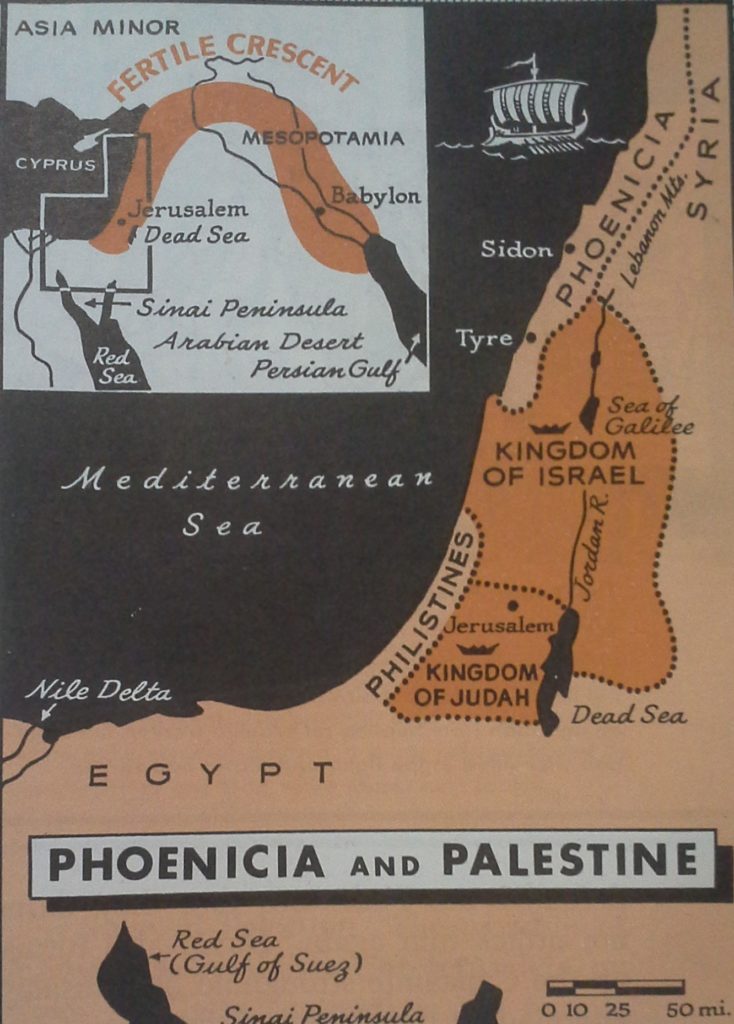
Palestine was part of the natural highway between Egypt and Mesopotamia. South of Phoenicia, in the coastal plain between the Mediterranean Sea and the deep valley of the Jordan River, lay another important centre of early civilization, Palestine. Like the Phoenicians, the people of this area had neither the wealth nor the population to compete successfully with the might of Egypt and Mesopotamia. There were, however, periods when their powerful neighbours were weak and they themselves were independent.
Among the early comers to this region were the Canaanites, a Semitic people related to the Phoenicians. The Canaanites lived in walled towns, adopted the cuneiform writing of the Babylonians and developed their own industries. Sometime after 1200 B.C. a warlike tribe called Philistines settled along the coast. (It was from Philistines that the name Palestine came.) The most important people to settle in this region were the Israelites. The Israelites spoke a Semitic language called Hebrew and are often referred to as Hebrews.
The Kingdom of Israel was established in Palestine. The Israelites once lived in the desert to the east of Palestine. Some of the Israelites settled in Egypt, but the Pharaohs kept requiring more and more taxes from them. To make bad matters worse, the Israelites were drafted to work for the Pharaohs — to help build their tombs, their temples, their palaces and other public works. The Israelites rebelled against such treatment, so about 1300 B.C. they escaped from Egypt. Their leader was Moses, an Israelite who had been an important official in the Egyptian government.
The story of the Israelites’ long search for freedom after years of slavery in Egypt is told in the Book of Exodus in the Old Testament. For many years they roamed the deserts of the Sinai Peninsula, near the northern end of the Red Sea. At last they pushed farther north and joined other Israelites who had forced their way into Palestine from the east. It took years for the Israelites to overcome the Canaanites. They also suffered from attacks by the Philistines. The Philistine soldiers, with crested helmets, bronze armour and iron swords and spears, were victorious over their poorly armed opponents and forced the Israelites to pay tribute. Not until the Israelites learned to unite were they able to win Palestine.
The first Israelite king, Saul, died after he was defeated by the Philistines. The second king, David — he had earlier won fame for killing the Philistine strong man, Goliath — so thoroughly defeated the Philistines that they dared not attack him again. David also turned on the Canaanite stronghold of Jerusalem and made it the capital of the Kingdom of Israel. David became a national hero. Not only was he renowned for his valour and skill in battle, but for the beautiful poems he wrote and sang, while accompanying himself on the harp.
Israel reached its greatest splendour under King Solomon. Solomon, David’s son and successor, won lasting fame for his wisdom and justness, but he also tried to equal or surpass the magnificence of other ancient rulers. Like the mighty rulers of Egypt and Mesopotamia, Solomon maintained a powerful army. He had 12,000 or more charioteers in his service. Solomon owned large herds of livestock as well as metalworks near the head of the Red Sea. His fleets of merchant ships traded along the shores of the Red Sea. The wealth from these activities and the taxes obtained from his subjects enabled Solomon to live in splendour. He built a fine palace and a famous temple in Jerusalem which were magnificent in the eyes of the Israelites whose labour and taxes had erected them.
Moses
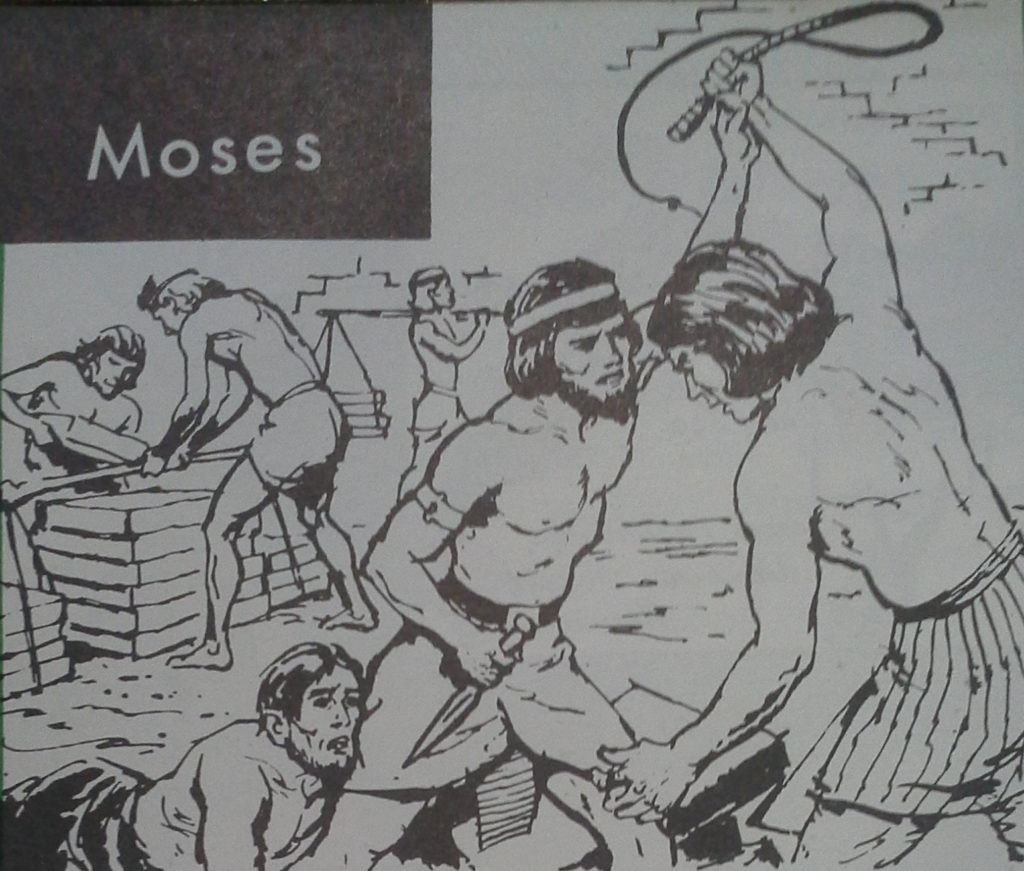
The Young Prince. Born in Egypt, Moses the Israelite grew up in the Pharaoh’s palace. He was better off than other Israelites, who were overworked by the Egyptians, but he did not forget his own people. When he stopped an Egyptian from beating an Israelite worker, the Egyptian was killed in the fight and Moses had to flee.
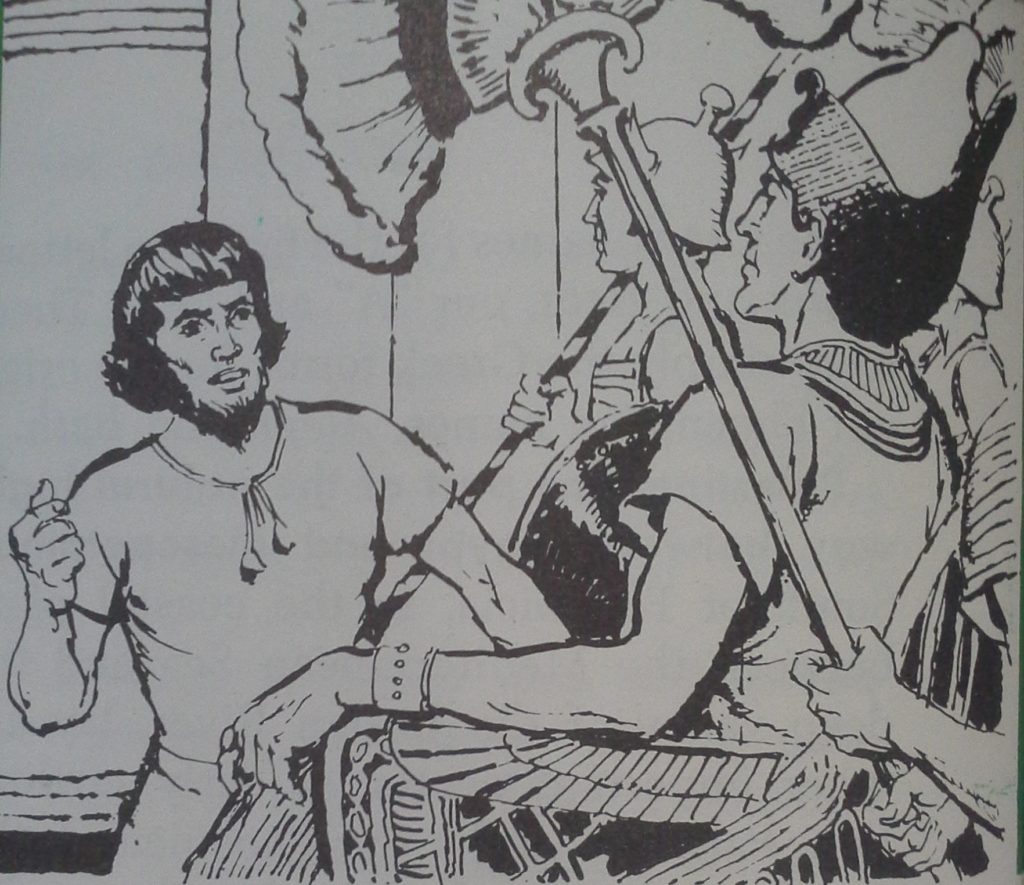
Leader of His People. In exile, Moses had a vision in which God told him to lead the Israelites to a new land of their own. Moses returned to Egypt and is shown here boldly demanding that the Pharaoh free the Israelites. Moses threatened him with God’s power until the stubborn Pharaoh finally let the Israelites leave.
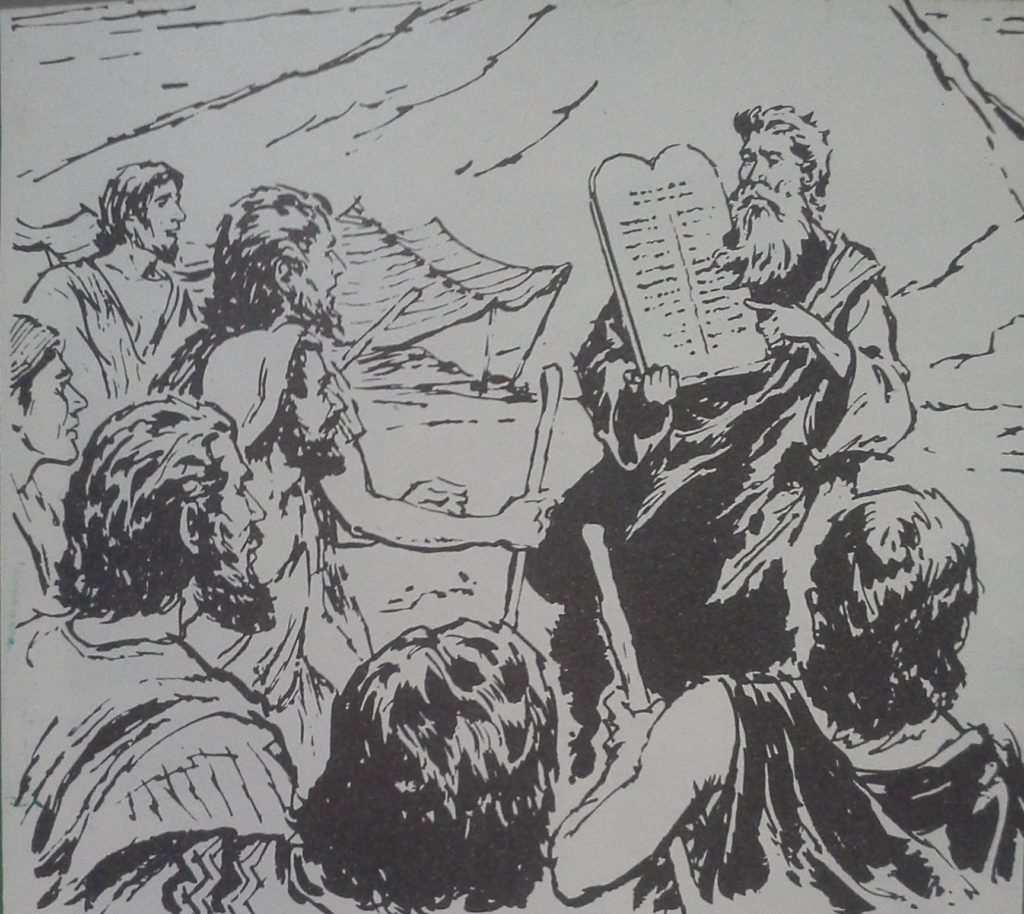
The Lawgiver. For years, Moses led the Israelites through the desert in search of their new land. When they were discouraged, he urged them to have faith in God. Alone on Mt. Sinai, Moses had a vision in which he heard God’s laws. He carved these Ten Commandments on tablets so the people could learn to obey them.
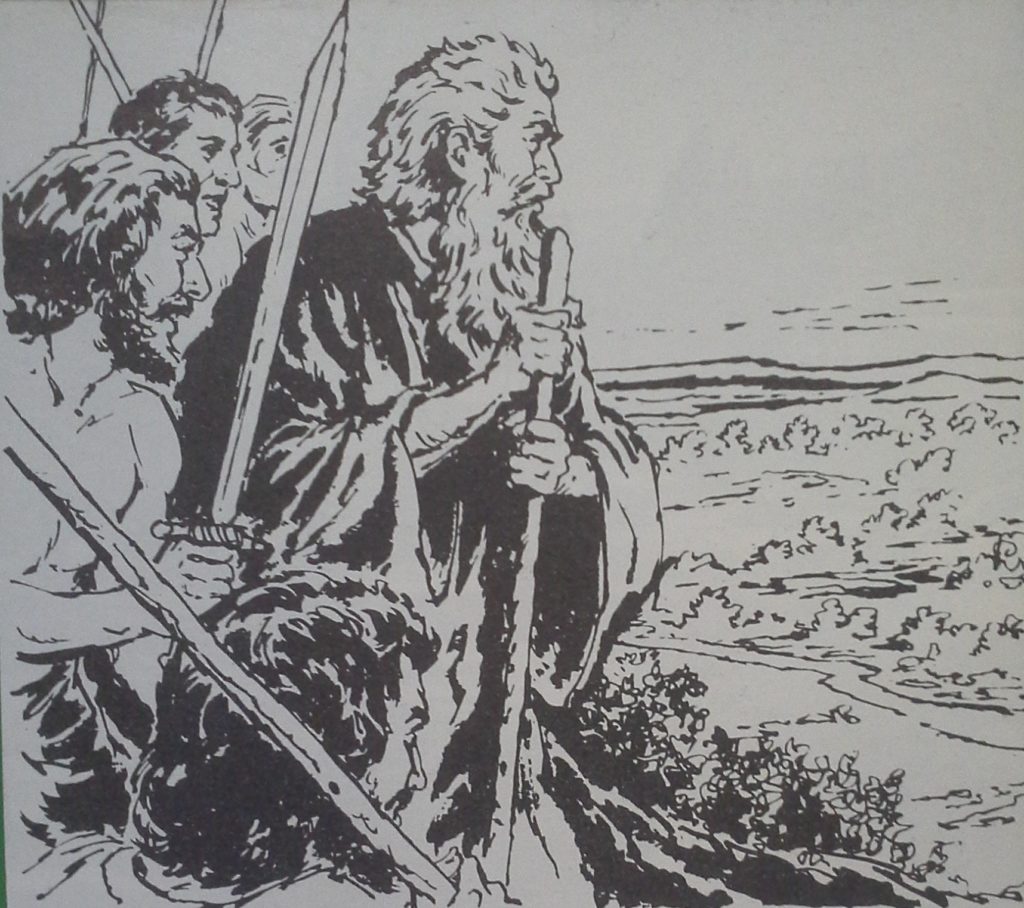
The Promised Land. Finally, Moses and the Israelites reached a peak overlooking Palestine, the land God had promised them. The long migration was over and Moses died content. The Israelites entered Palestine and made it the home of Judaism, a great religion based on the loyalty to one God which Moses had taught.
The Israelites were conquered. This period of Israel’s greatness was shortlived. About 900 B.C. Solomon died and his tax-weary people revolted. The former Kingdom of Israel then split into two parts: (1) a new Kingdom of Israel in the north; (2) the Kingdom of Judah in the south. These two small kingdoms quarrelled with each other and were no match for their grasping neighbours in Mesopotamia.
Israel’s downfall came first. The Assyrians invaded the little northern kingdom and in 722 B.C. forced the Israelites to leave their homes and country. To this day no one knows what became of those unfortunate people. The best guess is that they gradually mingled with their conquerors and became lost among them.
Judah’s downfall came more than a century later in 586 B.C. The mighty king of Babylon, Nebuchadrezzar, conquered Jerusalem and destroyed it. Then the victors carried off their captives to Babylon. Fifty years later the Persians conquered Babylon. The few remaining exiled Jews (as we now call them) and their families were permitted to return to Judah and Jerusalem was rebuilt. But the glory of Judah was not restored. Through the centuries, one conqueror after another occupied Palestine. Jews had no country they could call their own and became small parts of the population, or minority groups, in civilized countries the world over. It was not until very recent times that they regained their homeland and founded the new state of Israel.
The chief contribution of the Israelites was religious. The world’s great debt to the ancient Israelites is in the field of religion. Through hardship, persecution and exile they clung to an unshakable faith in God. From this faith stemmed at least (“At least,” because the followers of Mohammed, also, accept some of the religious beliefs of the Hebrews. ) two great religions, Judaism and Christianity. How did this come about?
The Israelites developed a belief in a single god. Like other ancient people, the Israelites first believed in many gods. Before they settled in Palestine, however, many Israelites had come to worship a single god, Yahweh or Jehovah. It was Jehovah, Israelites believed, who had led them from slavery in Egypt to freedom in Palestine. The worship of Jehovah was established at Jerusalem by David and later centered in the temple built by Solomon. Many of the Israelites, however, clung to the worship of other gods, so that it was a long time before Jehovah alone was worshiped in both Israel and Judah.
During the many years when they were captives in Babylon, the Jews still further developed their ideas about Jehovah. Usually defeated or exiled peoples of the ancient world accepted the gods of their conquerors. The homeless Israelites, however, not only clung to Jehovah as their god but began to think of him as the one or universal god of all people everywhere. In other words, there could be only one God. This idea was a remarkable advance in men’s thinking about religion.
Israelites developed high standards of conduct. Out of the religious ideas of the Israelites grew some of the highest standards of conduct which the world has ever known. The foundation of these standards was the Ten Commandments, which Israelites believed had been given to their leader Moses by Jehovah. Besides stating that the Israelites should worship no god but Jehovah, the Ten Commandments stressed such virtues as honesty, faithfulness, respect for parents and right attitudes towards one’s fellow men.
There were other Israelite laws or rules of conduct in addition to the Ten Commandments. In certain respects the laws of the Israelites were like the ones contained in Hammurapi’s Code, though many of the laws seem to us to be more just. For example, if an Israelite owned another Israelite as a slave, he had to free his countryman after seven years of service. No person could be put to death on the testimony of a single witness. Israelites were commanded to give just weight in their trading and to be generous to the poor and needy.
Israelites owed much to their religious leaders. The development of the Hebrew religion owed much to inspired preachers or teachers called prophets. The prophets were fearless men who dared to speak the truth as they saw it. When the Israelites wandered from the worship of Jehovah, with ringing words the prophets bade them return to the worship of the one true God. The prophets also held lofty ideals before their people. The Prophet Micah stated one of the noblest roles of human conduct in this sentence: — “What doth the Lord require of thee, but to do justly and to love mercy and to walk humbly with thy God.” Micah also looked forward to a time of universal peace When “nation shall not lift up sword against nation, neither shall they learn war any more.”
The Old Testament is a collection of Israelite literature. The experiences of the ancient Israelites are recorded in 39 “books” in that part of the Bible which is called the Old Testament. There you find the Israelite story of the creation of the world, the Ten Commandments and the other Laws of Moses. In it also are stories, poems and wise sayings called Proverbs. Some of the “books” deal with the history of the Israelites; others are the teachings of the prophets.
This collection of Hebrew writings not only is one of our finest inheritances from the past but has had tremendous influence on our modern world. Jews accept it as their sacred Scripture, while Christians look upon the Old Testament as the foundation for the teachings of Jesus.
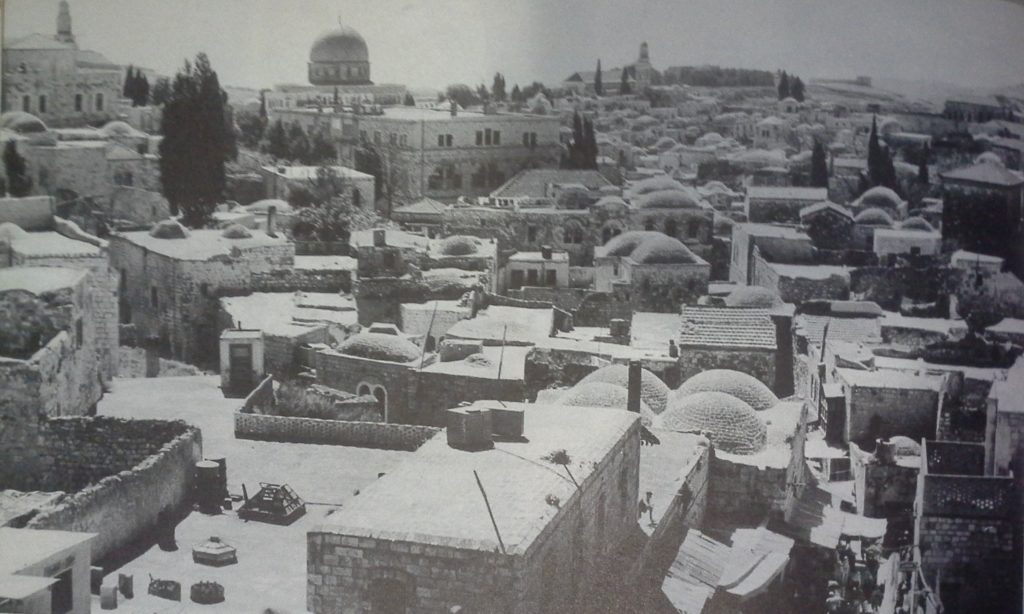
2. How Did the Hittites Spread Civilization in Asia Minor?
Not long before 1250 B.C., an Assyrian ruler wrote to a king of the Hittites asking for a shipment of pure iron. The Hittite king explained that he did not have a supply on hand. With his letter he sent a present of an iron dagger as a token of good will. These letters have been preserved and may be read today.
Who were the Hittites? Why would another ruler apply to the Hittite king for a supply of this new metal, iron? Archaeologists have found answers to these questions in Asia Minor.
Asia Minor was a crossroads between Europe and Asia. Northwest of Mesopotamia and pointing toward southern Europe is Asia Minor. Just as Phoenicia and Palestine were parts of a natural route between Egypt and Mesopotamia, Asia Minor lay between the rest of the Near East and Europe. Like all countries on natural routes of travel and migration, Asia Minor experienced one invasion after another as wandering tribes and armies moved east and west. Not only soldiers but hustling traders from Mesopotamia entered Asia Minor, bringing ideas as well as their wares.
The Hittites gained control of Asia Minor. About 1700 B.C. the leading people in Asia Minor were the Hittites. They had come from a part of southern Europe near the Black Sea. At the height of their power, they united Asia Minor in a great empire (1400-1200 B.C.) and conquered parts of Mesopotamia and Syria. A military handbook (if we may so name writings not in book form) has been discovered which shows that the Hittites were highly skilled in military matters. About 1200 B.C., however, their empire collapsed before new invaders.
The Hittites and neighbouring peoples introduced the use of horses. In their location at the crossroads between Europe and Asia, the Hittites were in a position to affect the ways of living of nearby peoples. Like various tribes from the areas around the Caspian and Black Seas, the Hittites were great horsemen. Horses roamed the grassy plains of central Asia. Doubtless it was these herds, brought southward by wandering horse-taming peoples, that supplied the Hittites with their horses. At first, horses were harnessed to two-wheeled chariots which were used in warfare and for hunting. These uses were quickly adopted by the older peoples of Mesopotamia, Syria and Egypt. Later, other people from the north brought to the Near East the custom of riding horses. The Assyrians, for example, used cavalry, or mounted troops, in their armies.
The Hittites introduced the Age of Iron. Far more important than the use of horses was the Hittite use of iron. You have already learned what advances were made possible by the use of copper and bronze, but copper and tin, from which bronze is made, were comparatively scarce. Iron, on the other hand, was available in many places. The mountains in northeastern Asia Minor contained much iron ore.
To the best of our knowledge the inhabitants of this region were the first to learn how to refine iron. Charcoal was used to make a hot fire and limestone was added to the iron ore. Then when the molten iron was pulled out and partly cooled, the impurities were beaten out on an anvil. The purified iron was then reheated and rehammered until it became harder and tougher than bronze.
Under Hittite rule, iron production became important and the knowledge of ironworking spread widely. Between 1200 and 1000 B.C., all the peoples of the Near -East and many in southeastern Europe began making tools and weapons of iron. Better products could be made with iron tools and troops with hard iron weapons had a great advantage in battle over an equal number of soldiers whose weapons were of bronze. Because iron was more plentiful, it was cheaper than bronze. The Iron Age had begun.
The Hittites engaged in trade and agriculture. In the empire of the Hittites were many large cities that were famous for their well-constructed buildings. In these cities were many busy craftsmen. The Hittites also paid a great deal of attention to farming and in particular to raising bees. This last occupation was important in ancient times, for honey was used rather than cane or beet sugar.
Ideas from Mesopotamia influenced the Hittites. The Hittites influenced other peoples, as you have seen and in turn picked up customs and ideas from nearby peoples. Consider, for example, the results of Hittite contacts with Mesopotamia. The Hittites worshiped their own gods, but they adopted such old Sumerian religious stories as the ones about the creation of the world. They also used the Babylonian system of cuneiform writing along with their own system of signs. They were influenced by Hammurapi’s Code, but developed a collection of their own laws which differed considerably from it. These laws, along with lists of historical events arranged by years, copies of treaties, royal decrees and documents of various sorts were collected in the libraries of the Hittite kings.
3. How Did the Persians Build an Empire Throughout the Near East?
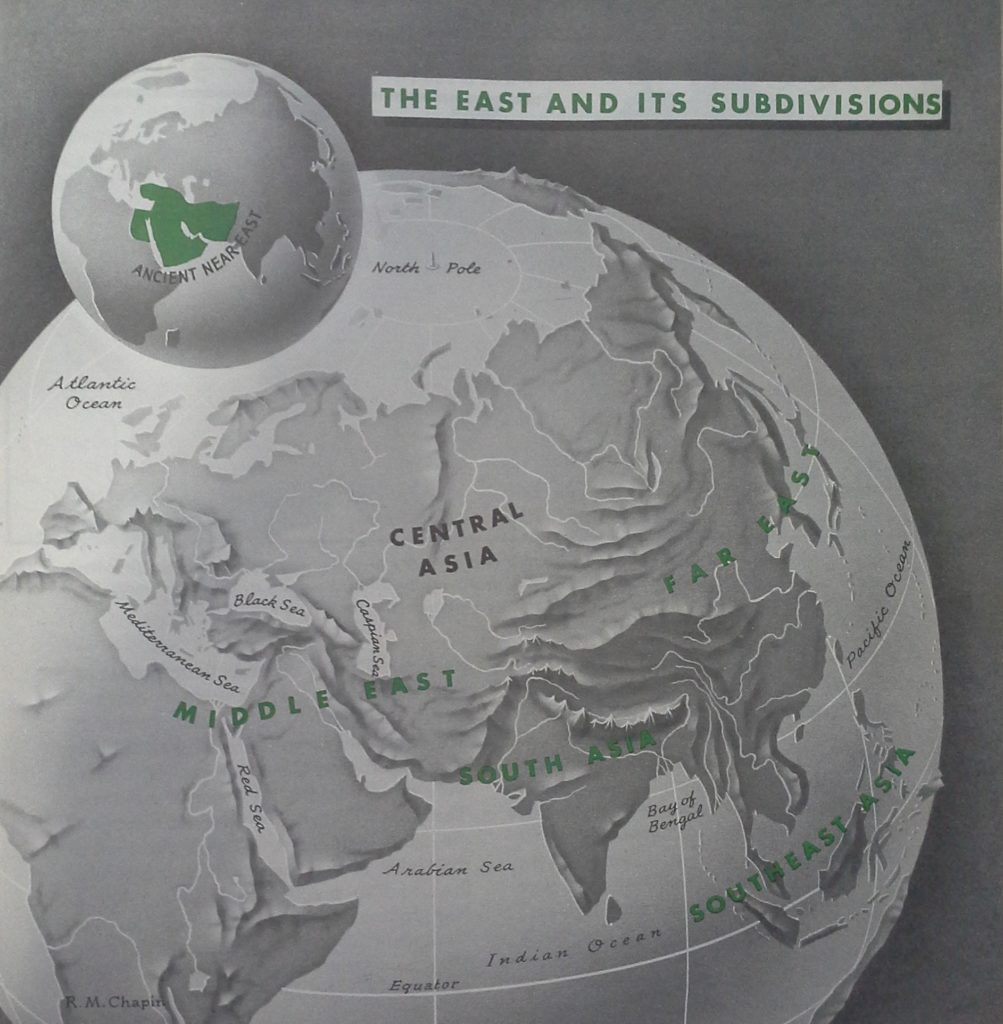
It would be fine if at all times the same terms were used for the same subdivisions. Unfortunately this has not been the case with the “East” terms. Asia is east of Europe and these names were given by Europeans to areas which were near, middle and far in relation to Europe. Far ancient and medieval times, the term Near East is generally used to describe all Southwest Asia as far as India (see coloured area on small inset globe). In modern times, the term Near East became limited to Egypt and the lands bordering the eastern Mediterranean, while the term Middle East was coined to describe the lands beyond (Iraq and Iran). Today, however, more and more people are using the term Middle East to refer to all the lands from Egypt to India. Nowadays, too, as Asian nations become increasingly important in world affairs, the terms South Asia and Southeast Asia are being used more and more.
East of old Babylonia and north of the Persian Gulf are the highlands of Iran, or Persia. The dry climate makes much of Iran unfit for farming, so its people live chiefly by tending their flocks. Here, centuries ago, lived the Medes and Persians and other related tribes. They had come into the highlands of Iran from the grassy plains north and east of the Caspian Sea. They spoke languages of the so-called Indo-European family to which English, German, Creek, Latin, French, Spanish, Portuguese and Italian also belong.
The Persians conquered a vast area. Once they had settled in Iran, these people came into contact with the civilization which the Sumerians and others had built in Mesopotamia. The Medes and Persians set out to make the rich cities and trade of the Mesopotamian people their own. The Medes took the first step when they helped Chaldeans from Babylonia crush cruel Assyria. The Medes then founded an empire which included the mountainous country from India to central Asia Minor.
This empire was short-lived. About 550 B.C. the Persians rebelled against the Medes and took over their empire. The victorious Persians did not stop here. Led by their able king, Cyrus, they conquered Mesopotamia, Asia Minor, Syria, Phoenicia and Palestine. Under Cyrus’ son, Egypt was conquered. By 500 B.C. Persian troops had pushed eastward to the lndus River and westward into southeastern Europe. The vast empire which the Persians built included an area of about 2 and a 1/2 million square miles and a population of 20 million. In other words, it had more than half the area of the United States today but less than one-ninth as many people. This empire lasted for about 200 years, until 330 B.C.
Persians were great warriors and tolerant people. The rapid success of the Persians was due, in part, to their skill in warfare. They were excellent horsemen and their mounted archers or bowmen contributed much to Persian victories. They also had large forces of foot soldiers armed with bows and spears. There were other reasons for Persia’s greatness. The kings of Persia gave their subject people many privileges. Among these were the rights to use their own language and laws and to practice their own religion. The following quotation from the Old Testament clearly shows how different was the Persian king Gyrus from Nebuchadrezzar, ruler of Babylon.
Cyrus the king made a decree concerning the house of God at Jerusalem. Let the house he builded . . . and also let the golden and silver vessels of the house of God, which Nebuchadnezzar [Nebuchadrezzar] took forth out of the temple which is in Jerusalem and brought unto Babylon, be restored. . .
Darius organized the government and constructed roads. The success of the Persian Empire also was due to the organizing ability of King Darius, one of the successors of Cyrus. King Darius divided the Empire into 20 sections or provinces. Over each province he set a governor responsible for the collection of taxes and a general to raise troops and keep order. There were also traveling representatives of the Great King. They were called the “Eyes and Ears of the King,” and they kept close watch over the work of the governors and generals throughout the Empire. Inefficient or scheming officials were reported to the Great King.
A vast network of royal roads linked all parts of the Persian Empire with Susa, one of the capital cities. Along these roads royal officials and troops moved to and from distant parts of the Empire. Royal messengers travelled long distances rapidly, changing to fresh horses at the rest stations along the way. Merchants and travellers moved at a more leisurely pace.
Coins came into wide use. The Persian kings issued coins of gold and silver which were used throughout the great Empire. They had probably adopted this idea from the Lydians, a people in Asia Minor whom they had conquered. (About 700 B.C. the rulers of Lydia first issued molded pieces of metal of certain weight with a design to indicate their value.) Because there were not enough Persian coins in circulation for all sales and purchases, however, there was still much trading in goods. People continued to pay a large share of their taxes in grain or other products.
Persian religion had many fine qualities. The Persians had a great religious teacher, Zoroaster. He taught that there was one supreme god, whose name was Ahura-Mazda. Persians believed that Ahura-Mazda was the creator of all life and was the god of light and truth. They believed there was also a spirit of darkness and falsehood who was in conflict with Ahura-Mazda.
Zoroaster taught that the god of light and truth would finally defeat the spirit of evil with the help of all Persians. They therefore must be loyal soldiers of Ahura-Mazda. They must avoid lies, wickedness, violence. They must have good thoughts and do good deeds. You can see that a religious belief of this kind would help people to live better lives. These high ideals even influenced the training given to sons of Persian nobles. The three things they were taught to value most were to ride well, to shoot straight and to speak the truth.
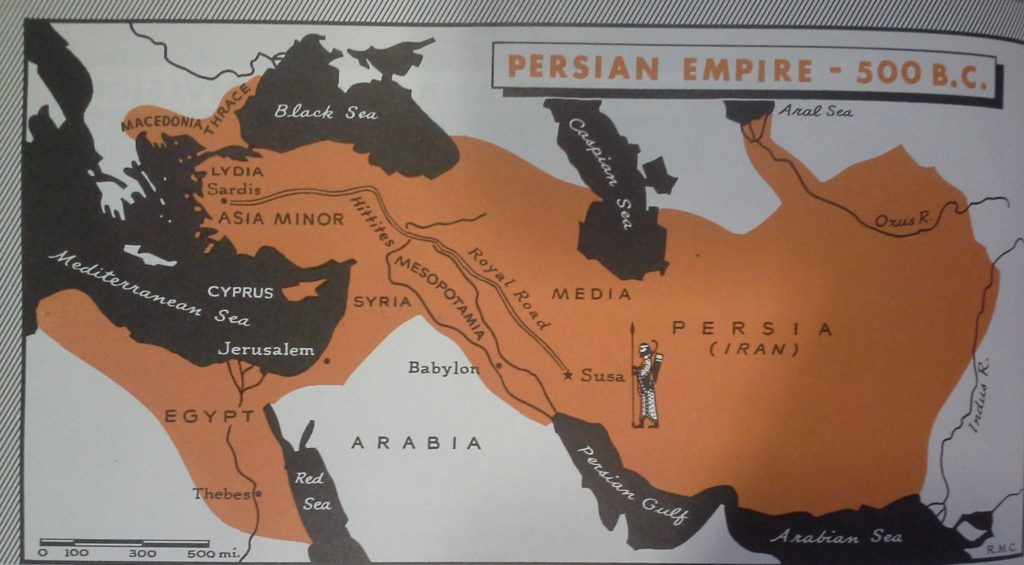
Persians learned from the people they conquered. Like all conquering peoples, the Persians adopted many ideas from their subjects. From Mesopotamia the Persians borrowed cuneiform writing, but simplified it by reducing to 43 the number of signs they used. This kind of writing is found on the remains of tombs, monuments, temples and palaces built by the Persians. For example, when Darius set up the Bisitun monument on the road from Persia to Babylon, he used Persian cuneiform to describe his exploits. For other purposes, the Persians generally used the language and alphabet of the Arameans. These were Semitic-speaking people who lived in Syria and Mesopotamia and who in turn had adopted their system of writing from the Phoenicians or their neighbours.
In still other respects the Persians borrowed from their neighbours. Their temples and palaces were modelled after the buildings they found in Mesopotamia, Egypt, and Asia Minor. The science and mathematics of conquered peoples were adopted too; so were their hand industries and other arts and crafts. In short, the Persians adopted the best ideas and ways of the peoples they conquered.
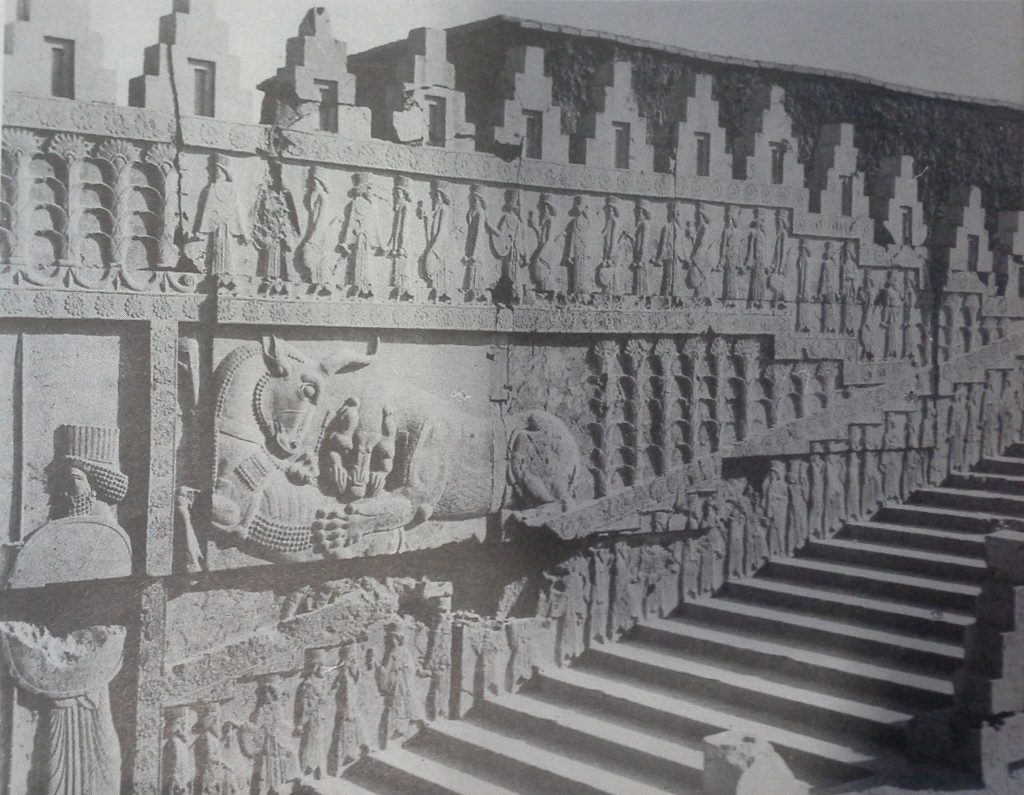
4. How Did Crete Become a Steppingstone in the March of Civilization?
In the tombs of several high Egyptian officials near their old city of Thebes is a series of unusual wall paintings. These were painted about 1500 B.C. and show groups of men carrying beautiful bronze and pottery vases, as well as bars of tin. There is nothing Egyptian in the appearance or the dress of the men in these pictures. Instead, they seem to resemble traders from the island of Crete. If you will look at the map, you will notice that Crete is like a steppingstone between Egypt and Greece. Notice, too, that Crete is much nearer to Greece than to Egypt. Finally, notice the Aegean Sea and its many islands north of Crete and between Asia Minor and Greece.
Archaeologists found remains of a lost civilization in Crete. What kind of civilization did these Cretan visitors to Egypt represent? Early in the 1900’s archaeologists working in Crete uncovered some remains which proved that a long-forgotten Bronze Age civilization had existed on that island. By comparing these remains with others found in nearby countries, the archaeologists concluded that civilization first reached Crete in two ways: (1) directly from Egypt; (2) indirectly from Mesopotamia by way of Palestine and Phoenicia.
Archaeologists figured out the answer to still another puzzle. The remains of the old civilization they had found showed that the ancient Cretans had been rich. Farming could not have made them wealthy, for neither Crete nor the nearby islands nor the adjoining shores of Greece had good farm land. Only grapes, figs and olives grow plentifully there. From what sources, then, had the wealth of the Cretans come? There were only two possible sources: industries at home and seaborne trade with other people.
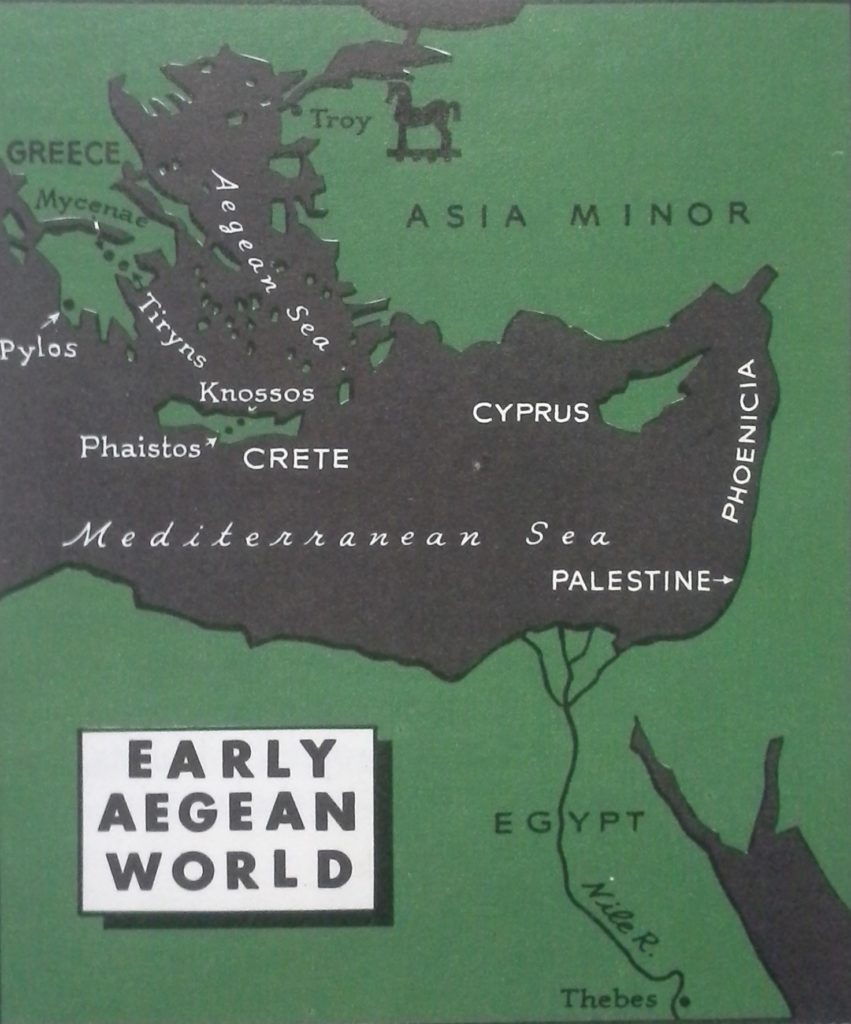
Cretans exchanged their handmade goods for raw materials. In high-powered ships suited for crossing the open sea, Cretan seamen sailed among the Aegean islands. Cretan sailors also visited Cyprus, Phoenicia, Palestine and Egypt and – even before the Phoenicians – explored the routes to southern Italy and Sicily. In their ships the Cretan sea traders carried cargoes of olive oil, fine pottery, bronze swords and daggers made in Crete. They brought back gold, silver, copper, tin, ivory, grain and other foods. With the rich profits of this trade the Cretans built prosperous towns, cities and luxurious palaces.
We know little of Cretan language, government, or religion. In writing the Cretans used a number of signs which apparently represented syllables. However, the written records they left appear to be mostly simple business accounts and lists of supplies. So, our knowledge of Cretan government and religion is limited to what we can guess from the remains found by archaeologists. There must have been rich and powerful rulers on Crete, judging from the ruins of the great palaces at Knossos and Phaistos. These palaces were destroyed by fire about 1400 B.C., probably by invaders from the Greek mainland.
No temples were built and no large statues of Cretan gods were set up. Cretan artists have left tiny statues of goddesses and numerous precious stones in seal rings engraved with scenes of worship. Carefully built tombs, lined and roofed with stone slabs, point to a Cretan belief in a life after death.
Cretan architecture and art were of high quality. Cretan architecture reached its height in the great palace of Knossos. This formed a square measuring 400 feet on each side. In the centre was a rectangular court which supplied light and air to the rooms that fronted on it. The building was two or three stories in height. Its walls were of sun-dried brick resting on stone foundations. The arrangements for water supply and drainage were excellent. As in Egypt, the inner surfaces of the palace walls were plastered and decorated with colourful paintings. In this and other things in which they imitated Near Eastern types, the Cretan artists did not copy slavishly.
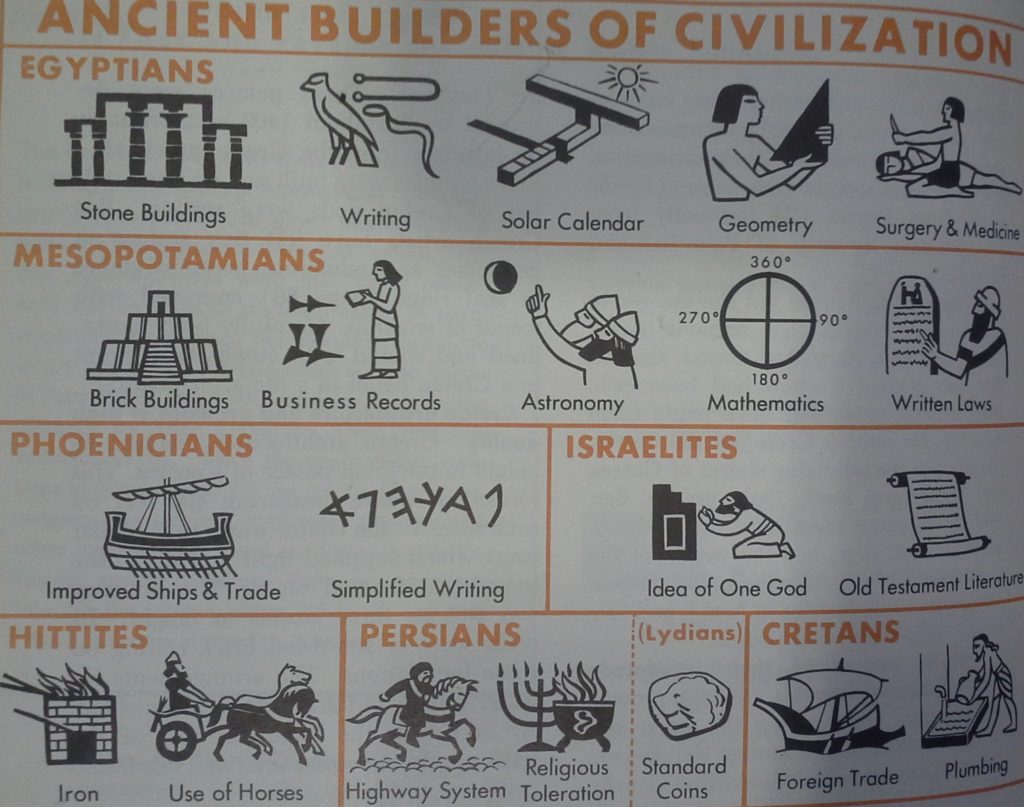
Craftsmen made vases in unusually graceful shapes and pottery decorated with beautiful coloured designs. They carved small figures in ivory, engraved seal rings and made many kinds of gold and silver objects and bronze daggers decorated with enamel.
These works of Cretan art give us a vivid account of Cretan life and help to make up for the lack of written records. For example, there are many pictures of the close-fitting embroidered jackets, long skirts and hats worn by the women.
Cretans were fond of shows and contests. Near the Cretan palaces were outdoor theatres with rows of stone seats. From these seats the spectators looked out on a paved space where entertainers danced and sang. Boxing and wrestling were favourite sports, but a much more dangerous amusement was bullbaiting. The Cretans turned wild bulls loose in arenas. Then weaponless young men and women — perhaps captives — dashed in. They thrilled spectators by grasping the horns of the angry beasts and then throwing themselves in somersaults over the bulls’ backs.
Civilization spread from Crete to the Greek mainland. Cretan seamen visiting other lands did a great deal to help the spread of improved ways of living. This was particularly true of southern Greece, which in those days was ruled by Greek people called Achaeans. Cretan and Achaean traders exchanged goods, ideas and the Achaean adopted many of the Cretan customs. Thus, the Achaeans learned to write their Greek speech in a script modelled on the Cretan. From 1400 to 1200 B.C. they displaced the Cretans as the great overseas traders of the Aegean area.
The chief remains of the Achaean civilization are at Mycenae, Tiryns and Pylos in southern Greece. On hills overlooking the towns, the Achaeans built fortresses. There the townspeople flocked in times of danger and there, safe inside the walls, stood the palace of the ruler. The Achaeans built their walls of huge stone blocks but made their palaces of sun-dried brick. They plastered and painted their palace walls as did the Cretans.
At Mycenae have been found tombs of Cretan style which contained many gold ornaments. Later Achaean kings had more imposing tombs. These were huge circular chambers dug in hillsides and approached by avenues paved with stone. The chambers were lined with rows of carefully fitted stones that narrowed to form domed roofs.
Another walled city was Troy, in Asia Minor. Its civilization closely resembled that of Mycenae, Tiryns and Pylos. Apparently, Troy was captured and destroyed soon after 1200 B.C. The attackers probably were Achaeans from the mainland and islands of Greece.
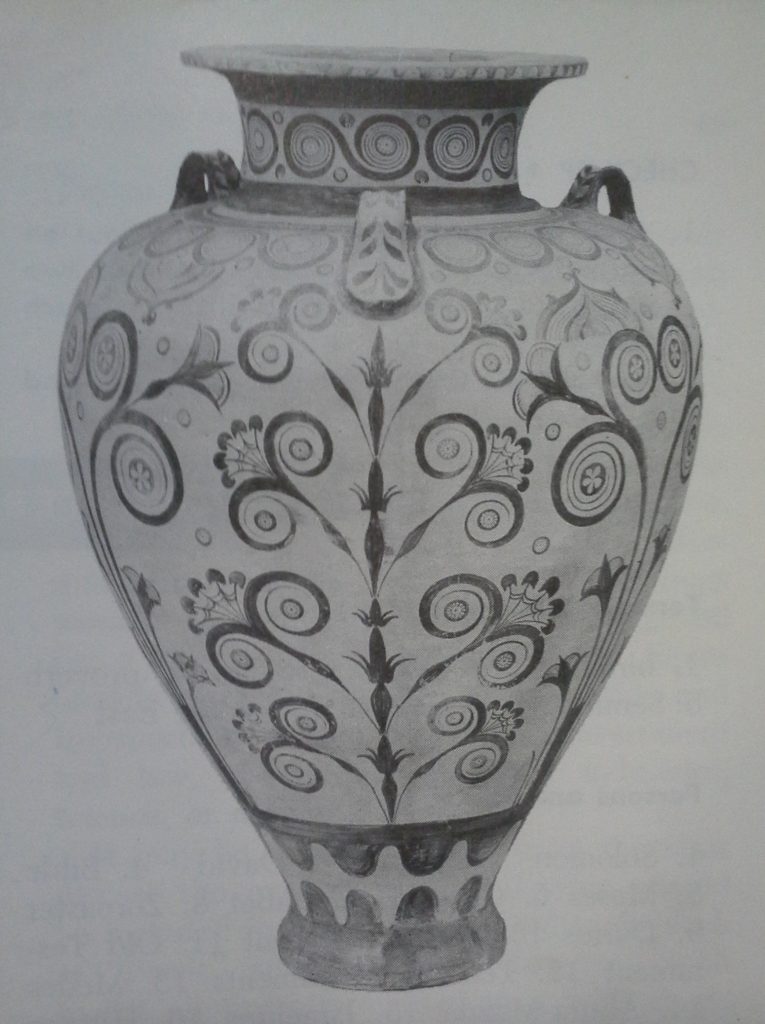
New invaders held back the progress of civilization. Achaean trade was ruined by migrating sea peoples who raided the Aegean area and the Near East after 1200 B.C. About the same time barbarian tribes from southeastern Europe near the Danube River overran Greece, destroyed the Achaean palaces and forced many Achaeans to migrate across the Aegean Sea. The new settlers introduced the use of iron into Greece, which now passed from the Bronze Age into the Age of Iron.
We have seen that civilization did not spring up suddenly. Instead it grew slowly, just as particles of rich soil, which are carried downstream year after year, build up gradually at the river delta. For civilization is made of the gathered particles of human experience — experience in agriculture, hand industries, science, writing, literature, law, government and religion.
New people with new ideas were to cultivate this rich soil and develop even more advanced civilizations. The first of these sprang up in Greece.
